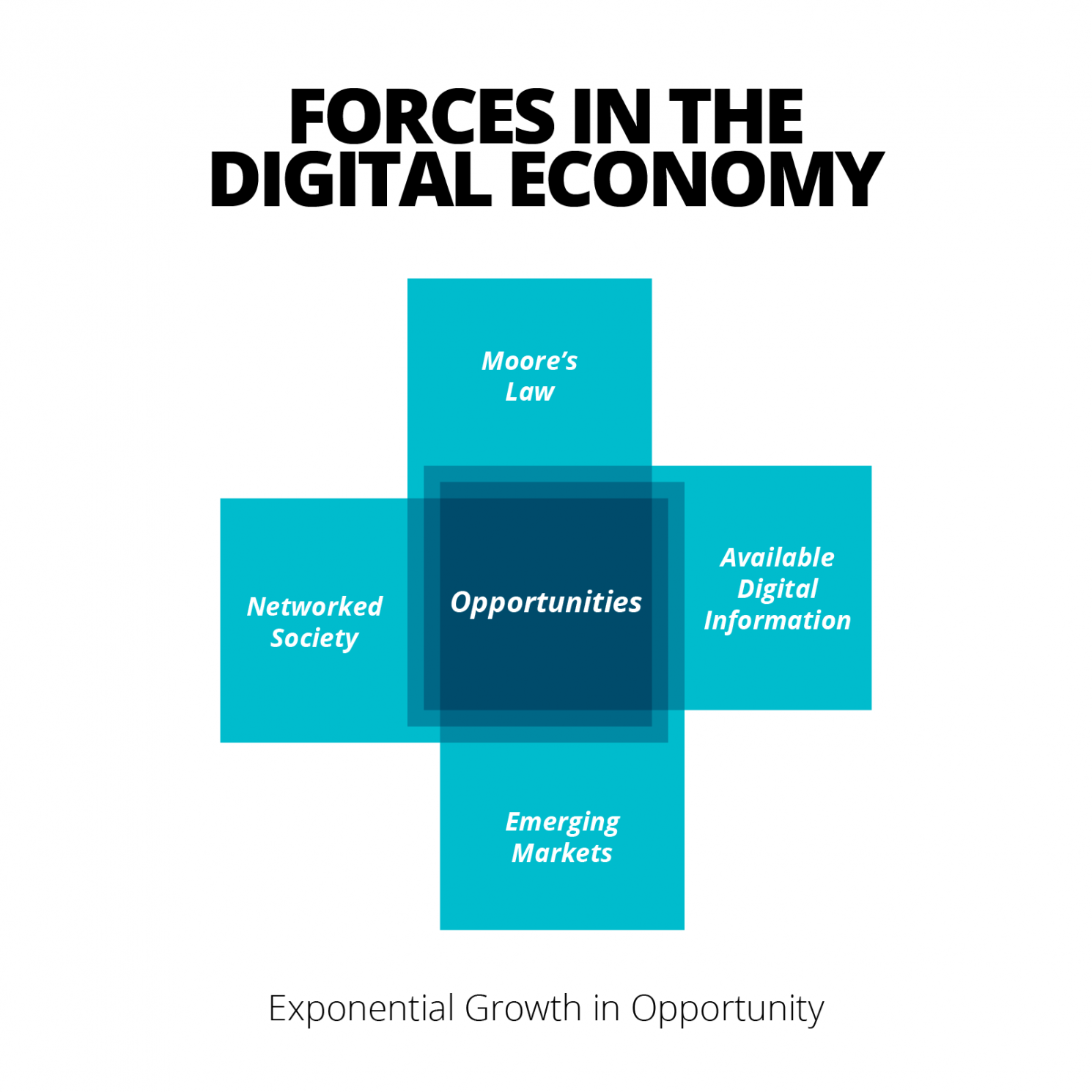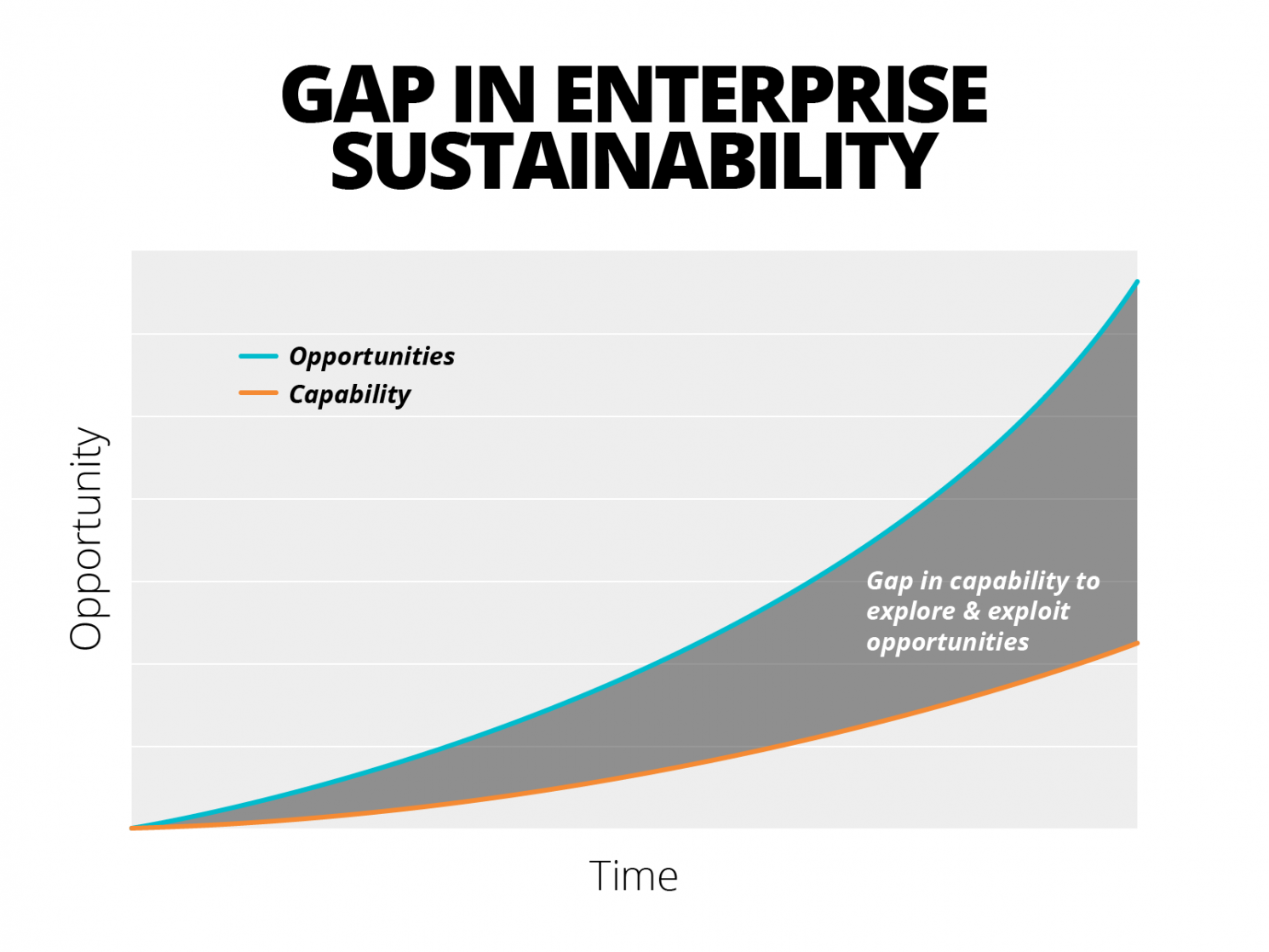
What’s the Hurry? Building a Digital Enterprise
Examples of the differences assault us in the media. Doug Stephens, author of The Retail Revival, says, “To put it simply, there has been no other point in history when so many aspects of disruptive change have collided and conspired to wreak havoc….”
Havoc such as reported on recently by USA Today on March 16, 2015, “Macy’s, JCPenney, Sears, Deb Shops, RadioShack, and Wet Seal are among retailers closing thousands of stores over the next year.”
The disruption is occurring in many industries, for example, “One banking CEO, says the industry is in the midst of a transition that occurs once every 100 years. Digitization is rewriting the rules of competition, with incumbent companies most at risk of being left behind." ["Strategic principles for competing in the digital age," McKinsey Quarterly, May 2014.]
Environmental and competitive forces are causing volatility, uncertainty, complexity, and ambiguity which in turn generate exponentially growing opportunities and threats.
This is not a new story. But it is a new version in which the gap between opportunities and the capabilities to exploit them grows wider by the day.
The cost of delay in reducing this Opportunity-Capability Gap cedes the ground to your competitors. Not just the traditional competitors, but also those new entrants that will emerge from some technology and business model blind spot and disrupt your market. Executives need to analyze their industries and their organization’s Opportunity-Capability Gap—what forces are driving it? How large is it? How fast is it changing?
Building the capabilities to manage this flow of opportunities as they flash by your enterprise window is the foremost challenge of our digital business era. The old saying, “here today, gone tomorrow” aptly sums up the problem. The first task—deepening understanding of the forces altering your competitive landscape. The second task—building the critical capabilities to respond to those forces. For most organizations today, the key capability deficit driving their widening gap is cutting-edge technology delivery.
Understanding the Forces
Let’s look at each of the environmental forces that are influencing the digital economy, starting with Moore’s Law.
Moore’s Law
First, if you don’t know what Moore’s Law is—you are already behind—because it epitomizes the rapid pace of technology change since the 1970s. Consider this; in 1985 Cray introduced the Cray 2 supercomputer with 1.9 GFLOPS of computing capability. It cost $32 million. In 2011 Apple introduced the iPad 2 which had roughly the same performance (on the LINPACK benchmark) for $500. Additionally, the iPad had two cameras, a GPS chip, three different wireless networking radios, eight hour battery life and it was smaller than a magazine, On every front—whether big data, social media, cloud, mobile, or the Internet of Things (IoT)—technology advancements are mind boggling difficult to keep up with, and trying to figure out how they will affect a particular business or industry increase the problems.
Digital Information
All of that computing power in the hands of so many people has created massive amounts of information in digital form. And, that information is growing at an exponential rate. While information creation has always been expensive, new business models like crowdsourcing have cleverly transferred that cost to the customers themselves. Because digital information is virtually free to reproduce and store, it has enabled product and service innovation and new business models.
Consider today’s ubiquitous GPS devices and applications like Google Maps and MapQuest. Without inexpensive digital mapping data they would not be viable products.
Similarly, free planetary weather data is available to anyone with an Internet connection. The impact on agriculture, transportation, entertainment, and every other industry is historic.
Imagine what will be possible as the IoT brings millions of new information producing devices online.
Networked Society
Vast amounts of computing power and digital information can be utilized to create innovative new products and services, and the Internet has created an entirely new marketplace for them.
As of the end of 2014, 40% of the world’s population has access to the Internet. Digital products and services can be delivered instantly at a fraction of the cost of traditional methods.
Social media services leverage the Internet to provide entirely new mechanisms for marketing and customer service and create unprecedented transparency. A service mistake on the other side of the world can now influence the buying decision of your customer through reputation based service directories and viral memes.
Crowdfunding services like KickStarter and Indiegogo leverage the Internet to provide access to a huge investor community. They have helped provide market validation and seed capital that is accelerating innovation worldwide.
The ability to identify like-minded people and to share information with them has also significantly impacted the global political landscape, as we saw in the Arab Spring that started at the end of 2010. Organizers leveraged the Internet to help organize and coordinate demonstrations to maximum effect and regime change followed.
Clearly our massively networked society has dramatically and forever altered the course of human history.
Emerging Markets
Emerging markets are altering the competitive landscape by increasing market size for existing products and services and creating new market segments.
Traditional suppliers can use their existing business models and infrastructure to capture those customers but they are vulnerable to disruption. New competitors, unencumbered by legacy systems, know how to leverage technology to address emerging market customers.
Cultural differences cause some existing business models to be less effective than when originally introduced. Those cultural differences also create new opportunities that were previously unavailable. The world shrinks as organizations learn about new customers and the inhabitants of our planet learn to understand each other better through access to information.
All of these environmental forces conspire to create exponential growth of opportunities. There are opportunities to solve customer’s problems in entirely new ways and to create new business models.
More havoc occurs when environmental factors interact to create more complexity and potential for disruption. These interactions raise questions like: How are emerging economies impacting or impacted by low-cost networking? How are billions of mobile devices impacting available consumer data, and vice versa? How do these complex interactions of environmental factors impact your enterprise? And maybe most important, how much time do you have to respond? Not much probably!
Building the Right Digital Age Capabilities
To meet the challenges of a changing and uncertain world, organizations must be good at doing many things, but be great at a few critical things, and those are: complex innovation, enterprise transformation, and cutting-edge technology delivery.
Complex Innovation
The type of innovation needed today is also changing. Innovation must solve more complex problems, it must be continuous (not sporadic), and it must come from across your organization. “As new challenges arise with different constraints and opportunities, new innovation models will evolve to serve them,” says Dan McClure in his article series on innovation. Historical challenges gave rise to innovation strategies that focused on big-investment new products (transistors from Bell Labs), incremental improvements (kaizen practices), and emerging markets (mobile apps).
Your enterprise may need to employ traditional strategies in certain circumstances—but they are not enough to thrive in the future. Today, enterprises must innovate in many dimensions, not just product development, and they must employ strategies that work in complex, multi-dimensional ways. For example, traditional product innovation focused on coming up with products that were introduced into the same business model as previous products. New products often require innovative new business models, directed to a diverse customer audience, and delivered via new distribution methods. Complexity reigns.
Enterprise Transformation
In today’s world, you must be an innovator and establish an enterprise culture that fosters continuous innovation. Networking and mobile technology are decimating standardized products. Consider Dominos Enterprises in Australia and their new Pizza Mogul initiative, in which anyone can become a “mogul” to create and market their signature pizza. These Moguls created more than 80,000 unique pizzas in the first 6 months. You might not go for an orange, pepperoni, squash pizza—but someone might. If your pizza place sells only 12 standard kinds, how do you compete? The capability to think about new products, new business models, and new technology requires a transformation in management culture.
Environmental forces create opportunities that you need to exploit before your competitors take advantage of the opportunity. Many companies emerged from the global financial crisis of the mid 2000’s in efficiency mode, just as many of the external forces mentioned about drove the need for a responsiveness strategy. A responsiveness strategy means both creating and responding to change rapidly in order to thrive in our digital economy. It means a new management culture for the digital age.
Once the responsive enterprise transformation goals have been articulated, leaders must then articulate what kind of organization would be needed to achieve those goals. This challenge addresses culture because the behaviors that drove efficiency aren’t the ones that can drive the responsiveness required for a digital enterprise. Whether you call it adaptive leadership, or radical management, or lean enterprise—cultural transformation is the foundation of enterprise transformation.
Cutting-edge Technology Delivery
The third core capability required to deliver on the promises of a digital business is cutting-edge technology and in particular software delivery capability.
“As digital technologies relentlessly reshape competition, products and services increasingly depend on software for differentiation and performance. Despite the mission-critical nature of software, it gets surprisingly little attention in the C-suite. New research suggests, however, that companies pay a price when they undervalue the strategic importance of producing excellent software." ["The perils of ignoring software development," McKinsey Quarterly, 2015]
Again, the strategies of the past that focused on efficiency led many CEOs to view IT as a cost center to be run as efficiently as possible. The legacy leaves many organizations with huge technical debts—from poorly maintained legacy systems to outdated processes to staff with trailing-edge capabilities. Organizations are, in general, moving far too slowly to build their technical capabilities for the burgeoning digital era.
One measure, or more correctly an indicator, of an organization’s technical capability is their agile software development maturity (in areas such as advanced technical practices, continuous delivery, Kanban, product management, and customer experience design).
Into the Future
Are you too late? Where is your enterprise on the opportunity-capability gap curve? Does your vision outstrip your capability? Is your CEO, CMO, CxO heavily involved in your software delivery capability building? Do you have a system for identifying and tracking opportunities during discovery, start up, and scaling phases? Do you have a responsiveness-based portfolio management system for allocating investment dollars? Are you innovating in critical strategies? Are you transforming your entire enterprise culture to be more adaptive, flexible, and lean? Answering these questions is not a project, but an ongoing program of continuous learning and adaptation.
Start yesterday!|
The next articles in this series will provide specific recommendations about how to build the capabilities required to narrow your Opportunity-Capability Gap.
Disclaimer: The statements and opinions expressed in this article are those of the author(s) and do not necessarily reflect the positions of Thoughtworks.














